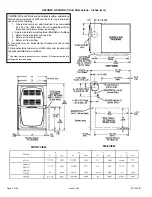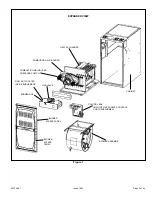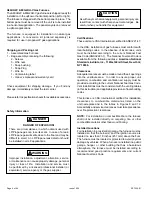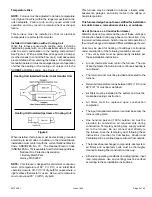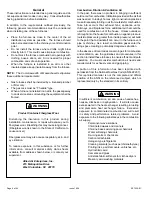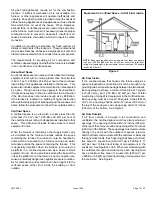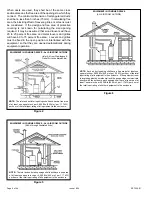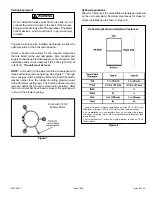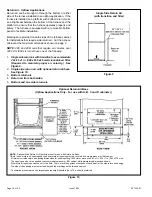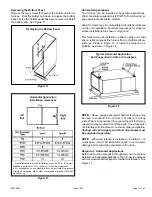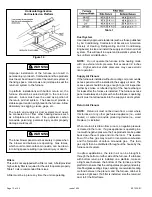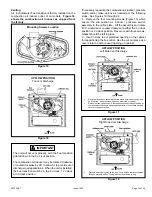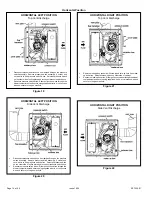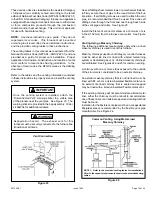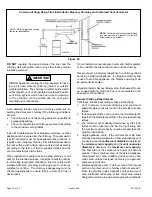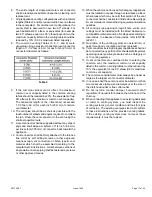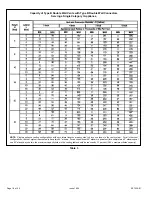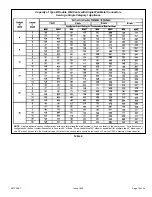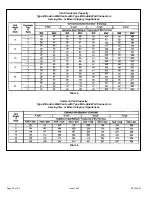
507335-01
Page 5 of 44
Issue 1624
Temperature Rise
NOTE:
Furnace must be adjusted to obtain
a
temperature
rise (high and low fire) within the range(s) specified on the
unit nameplate. Failure to do
so
may cause erratic limit
operation and may result in premature heat exchanger
failure.
This furnace must be installed so that its electrical
components are protected from water.
Installed in Combination with a Cooling Coil
When this furnace is used with cooling units, it shall be
installed in parallel with, or on the upstream side of, cooling
units to avoid condensation in the heating compartment.
See Figure 2. With a parallel flow arrangement, a damper
(or other means to control the flow of air) must adequately
prevent chilled air from entering the furnace. If the damper is
manually operated, it must be equipped to prevent operation
of either the heating or the cooling unit, unless it is in the
full
HEAT or COOL
setting. See Figure 2.
This furnace may be installed in alcoves, closets, attics,
basements, garages, and utility rooms in the upflow or
horizontal position.
This furnace design has not been certified for installation
in mobile homes, recreational vehicles, or outdoors.
Use of Furnace as a Construction Heater
Allied Air does not recommend the use of these units as a
construction heater during any phase of construction. Very
low return air temperature, harmful vapors and operation of
the unit with clogged or misplaced filters will damage the unit.
Units may be used for heating of buildings or structures
under construction, if the following conditions are met:
•
The vent system must be permanently installed per
these installation instructions.
•
A room thermostat must control the furnace. The use
of fixed jumpers that will provide continuous heating is
not allowed.
•
The return air duct must be provided and sealed to the
furnace.
•
Return air temperature range between 60°F (16°C) and
80°F (27°C) must be maintained.
•
Air filters must be installed in the system and must be
maintained during construction.
•
Air filters must be replaced upon construction
completion.
•
The input rate and temperature rise must be set per the
furnace rating plate.
•
One hundred percent (100%) outdoor air must be
provided for combustion air requirements during
construction. Temporary ducting may supply outdoor
air to the furnace. Do not connect duct directly to
the furnace. Size the temporary duct following these
instructions in section for Combustion, Dilution and
Ventilation Air in a confined space with air from outside.
•
The furnace heat exchanger, components, duct system,
air filters and evaporator coils must be thoroughly
cleaned following final construction clean-up.
•
All furnace operating conditions (including ignition, input
rate, temperature rise and venting) must be verified
according to these installation instructions.
When installed, this furnace must be electrically grounded
according to local codes. In addition, in the United States,
installation must conform with the current National Electric
Code, ANSI/NFPA No. 70. The National Electric Code
(ANSI/NFPA No. 70) is available from the following address:
National Fire Protection Association
1 Battery March Park
Quincy, MA 02269
NOTE:
This furnace is designed for
a
minimum continuous
return air temperature
of
60° F (16°C) or an intermittent
operation down to 55° F (13°C) dry bulb for cases where
a
night setback thermostat is used. Return air temperature
must not exceed 85° F (29°C) dry bulb.
Figure 2
Heating Unit Installed Parallel to Air Handler Unit
Heating Unit Installed Upstream of Cooling Unit
Summary of Contents for 80G2UH-V
Page 29: ...507335 01 Page 29 of 44 Issue 1624 ADJUSTING AIRFLOW Table 11 ...
Page 41: ...507335 01 Page 41 of 44 Issue 1624 Wiring Diagram Figure 41 ...
Page 42: ...507335 01 Page 42 of 44 Issue 1624 Typical Field Wiring Diagram Figure 42 ...
Page 43: ...507335 01 Page 43 of 44 Issue 1624 Start Up Performance Check List UNIT SET UP ...
Page 44: ...507335 01 Page 44 of 44 Issue 1624 UNIT OPERATION ...


